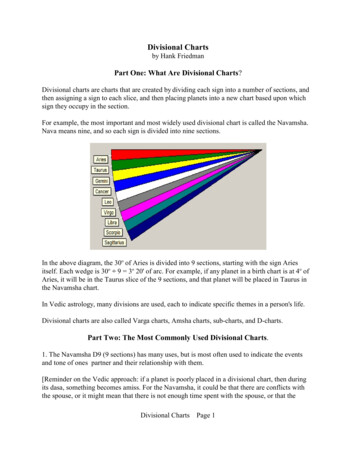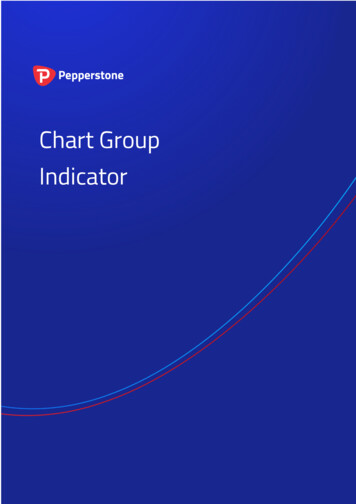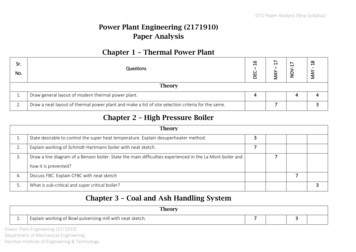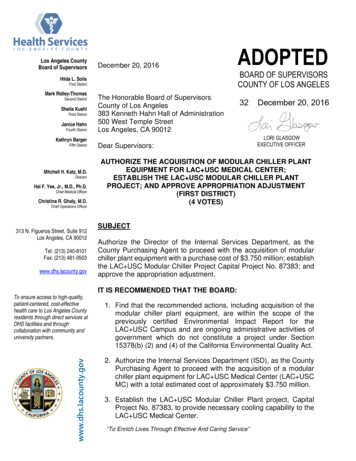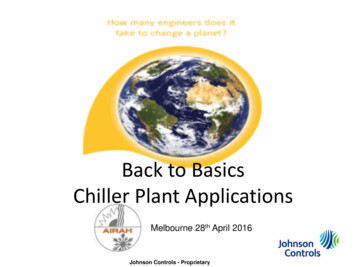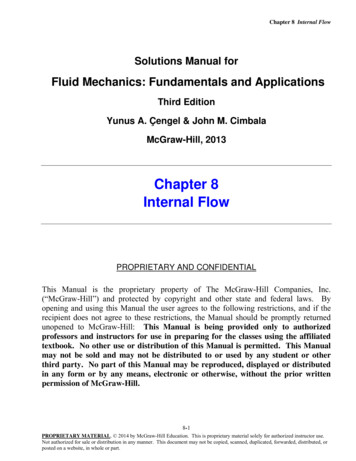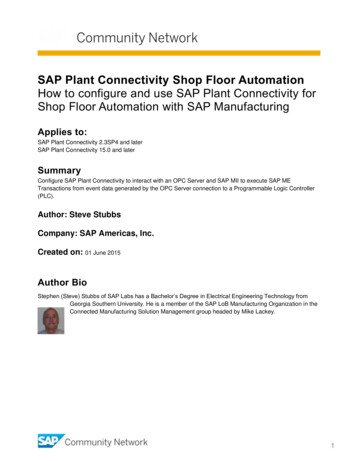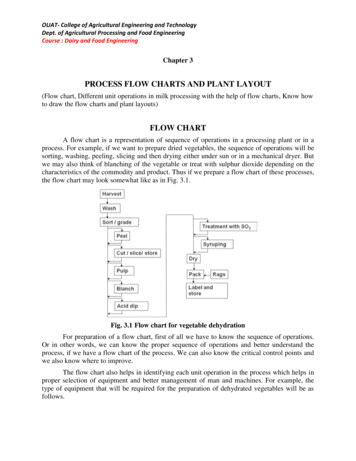
Transcription
OUAT- College of Agricultural Engineering and TechnologyDept. of Agricultural Processing and Food EngineeringCourse : Dairy and Food EngineeringChapter 3PROCESS FLOW CHARTS AND PLANT LAYOUT(Flow chart, Different unit operations in milk processing with the help of flow charts, Know howto draw the flow charts and plant layouts)FLOW CHARTA flow chart is a representation of sequence of operations in a processing plant or in aprocess. For example, if we want to prepare dried vegetables, the sequence of operations will besorting, washing, peeling, slicing and then drying either under sun or in a mechanical dryer. Butwe may also think of blanching of the vegetable or treat with sulphur dioxide depending on thecharacteristics of the commodity and product. Thus if we prepare a flow chart of these processes,the flow chart may look somewhat like as in Fig. 3.1.Fig. 3.1 Flow chart for vegetable dehydrationFor preparation of a flow chart, first of all we have to know the sequence of operations.Or in other words, we can know the proper sequence of operations and better understand theprocess, if we have a flow chart of the process. We can also know the critical control points andwe also know where to improve.The flow chart also helps in identifying each unit operation in the process which helps inproper selection of equipment and better management of man and machines. For example, thetype of equipment that will be required for the preparation of dehydrated vegetables will be asfollows.
2Equipment required for vegetable dehydration Wash tanks or special washers Knives, peelers, small peeling machines Fruit and vegetable choppers, cutters, slicing and dicing machines Pulpers, liquidizers, steamers, or at a large scale, pulper-finishers Boiling pan, heat source, wire basket or steamer Weighing scales or scoops, sulfuring cabinet or food grade plastic tank Weighing scales or scoops, boiling pan, heater, food-grade tank, muslin cloth filter Sun-drying, solar dryer, any type of suitable dryer Electric heat sealer for plastic bagsSo now we have understood that the flow charts are very important for understanding andmonitoring a process. In this section, we will discuss how the flow charts are prepared for somecommon milk processing operations. In fact this will also help you in understanding the methodsof preparation of these specific products.Fig. 3.2 Flow chart for preparation of pasteurized milkDairy and Food Engineering- Prof. S K Dash
3Fig. 3.3 Flow chart for preparation of sterilised milk (In-bottle sterilization)Fig. 3.4 Flow chart for preparation of flavoured milkDairy and Food Engineering- Prof. S K Dash
4Fig. 3.5 Flow chart for preparation of butter milkFig. 3.6 Flow chart for preparation of butterDairy and Food Engineering- Prof. S K Dash
5Fig. 3.7 Flow chart for preparation of ice creamFig. 3.8 Flow chart for preparation of cheddar cheeseDairy and Food Engineering- Prof. S K Dash
6Fig. 3.9 Flow chart for preparation of cottage cheeseFig. 3.10 Equipment flow chart for preparation of cottage cheeseFig. 3.11 Flow chart for preparation of evaporated milkDairy and Food Engineering- Prof. S K Dash
7PLANT LAYOUTPlant layout is the arrangement of equipment/ machines/ facilities in a plant for theefficient functioning of the whole system with a view to maximize the profit.We may consider any food processing operation as a transformation process. In a fruitsand vegetables processing plant, the raw materials (raw fruits and vegetables) are transformedinto finished product (processed fruits and vegetables) by a series of operations, whose sequenceand numbers are specified for the input. For example, the sequence of operations that are carriedout in an onion dehydration plant, can be shown as in Fig. 3.12.ReceptionCleaningSize gradingRemoval of tops, rootsand outer leavesDryingDrainingSorting / orageFig. 3.12: Preparation of dehydrated onionWe can not change the sequence of these operations as per our desire. In this case, afterreceiving, the dust and dirt sticking to the surface of the onion bulbs must be cleaned first. Thenthe bulbs should be graded for size, then the tops and roots be removed, and so on. Therefore, forefficient utilization of energy, labor (these are the other inputs than the raw materials), and ofcourse money, the cleaning section should be kept adjacent to the receiving section followed bythe grading section, and so on.Now, suppose we place the size grader between the receiving yard and the cleaningsection or the drying section between the packaging section and storage section, what do youthink will happen? It will unnecessarily increase the materials handling cost and time, and reduceoverall performance. In addition, it will also cause collision between the workers and wastage ofmanpower and energy. Hence, we should arrange the work areas, equipment and auxiliaryfacilities judiciously in the processing plant such that the operation will be economical and theemployees will feel safe and satisfying.Thus, the arrangement of the different facilities and equipment in a food processing plantplays an important role in the overall viability of the project. This physical arrangement of theindustrial facilities is known as plant layout. The arrangement also includes the space neededfor material movement, storage, indirect labor and all other supporting activities, or services, aswell as for operating equipment and personnel.Advantages of good plant layoutIn general, a good plant layout will permit simple and forward movement for the productand containers through the plant. Let us take a simple example.Dairy and Food Engineering- Prof. S K Dash
8In Fig. 3.13, I have shown you some equipment in boxes, in which the numbers show thesequence of operations. Say, the first operation (may be cleaning) will be done by theEquipment-1, the second operation by Equipment-2 and so on. The Equipment-6 does thepacking and then the product has to be taken out of the factory. I have shown you four possiblearrangements for these equipment. Which pattern or arrangement do you think will be the best toreduce the cost of operation and improve performance?1221R34OR34A56A5DArrangement -1646132Arrangement -3DArrangement -2R321O5OADRO456Arrangement -4ADFig. 3.13 Understanding what plant layout meansmeansObviously Arrangement No.4 will be the most ideal one. Remember, we are yet to learnthe general guidelines for a good plant layout. However, you will definitely agree that if themachines are not properly arranged, as in the cases 1, 2 or 3, the total material movement insidethe plant is unnecessarily increased. Besides, there is also crossing of the flow paths, whichwould interrupt a smooth operation.The sequence of operations is one of the major criteria, but not the only criteria fordesigning plant layout, which we will discuss later in the unit. But as we are discussing about theadvantages of a good plant layout, we wee that a proper plant layout helps us in reducing cost ofoperation, which is very important for survival of any industry.A good plant layout, in general, has the following advantages.Dairy and Food Engineering- Prof. S K Dash
9 Saving in floor space;Better utilization of machine and man power, and services;Reduced material handling, thus saving in labor and cost, less productiondelays;Reduced inventory in process, thus saving in investment and working capital;Increased output/ production per unit time, labor, money and energy; andEasier and better supervisionIn addition to the above, a properly designed layout helps to maintain proper sanitationand safety standards in a plant. It reduces confusion between different sections of workers, andimproves moral of the workers. All these factors directly affect the output. Careful layoutplanning can identify and remedy bottlenecks and trouble spots before the plant is built, and thusprevents troubles later.Requirements / factors in planning layoutsAs we have already discussed, the basic objectives of a good plant layout are smoothoperation and reduced cost in handling and processing. Good layout must also includearrangement of specified areas for processing, storage and handling in efficient coordination.This should also consider the following factors. Proper placement of equipment and conveying machines- All the equipment andconveying machines should be arranged in proper coordination depending on the flowsequence and characteristics of equipment. Depending on requirements, the layout can besingle level, multi storied, or combined designs.Economic distribution of services- The layout, in addition to proper placement ofimportant equipment, should also have provision for efficient and economic distributionof water, process steam, power, and gas, etc. The distribution lines for these utilitiesshould not interrupt the normal working of the people.Suitable use of floor and elevation space- This will depend on the type of foodprocessing plant and the special facilities and equipment used for the system.New site development or addition to a previously developed site- If we want to planthe plant on a site, which already has some installed equipment, office rooms and storagegodowns, etc., then the layout should consider these amenities. Our objectives will be tosee that minimum alterations or modifications are made to the existing facilities withoutaffecting the overall objective of the layout.Future expansion- The layout should have sufficient provision for future expansion.Suppose at this stage we are interested in a 1 tph (tonnes per hour) dehydration plant forginger. But after some years, we want to increase the capacity to 4 tph or want to preparedehydrated onion and garlic from the same plant. It requires installation of some moreequipment. We will also need more space for go down and processing operations. In thatcase, we will be in trouble if the present arrangement doesn’t have sufficient provisionfor expansion. Another alternative is to install a completely new plant in another location.It will involve some unnecessary cost and further it will also be difficult to manage twoplants at two different locations. To overcome such type of difficulties, the layout shouldhave provision for future expansion.Waste disposal problems- The layout should have adequate provision for disposal ofsolid, liquid and gaseous wastes. Or else, the project may not be even passed by thepollution control authorities.Dairy and Food Engineering- Prof. S K Dash
10 Safety considerations- We should keep the equipment or areas having chances ofhazards like fire or explosion away from normal working of the people. For example, weshould isolate the boiler room.Other factors - The building code requirement, weather conditions like extreme high orlow temperatures, maximum wind sped in the area, etc. are some other factors whichneed to be considered during planning the layout.Types of layouts There are generally two types of product flow in food processing industry, namely, lineflow process and intermittent flow process. In the line flow process, the product flowsfrom one operation to the next in a prescribed sequence as in the preparation ofhomogenized and pasteurised milk in an automatic dairy plant. The individual work tasksare closely coupled. There may be side flows, which impinge on this line, but they areintegrated to achieve a smooth flow. In an intermittent flow process the production iscarried out in batches at intermittent intervals. In this case, we can organize theequipment and labor into different work centers by similar types of skill or equipment.The product can be sent to any of the work centers as per requirement. For example, in amango processing plant, the mango slices can be sent to a dehydrator for preparing driedmango slices or sent to the canning section for getting canned mango slices, or may befilled with syrup and frozen to prepare frozen mango slices. Similarly mango pulp can beprocessed in different work centers to get frozen mango pulp, mango squash, mangonectar, mango bar, mango powder or mango cereal flakes. Or, say the particular squashmanufacturing section can be used for different commodities like mango, pineapple, limeor watermelon at different times. This often results in a jumbled pattern of flow. Thevolume of product handling can be changed easily in this type of flow.LINE FLOW- PRODUCT FORM OF LAYOUTINTERMITTENT FLOW-PROCESS FORM OF LAYOUTFig. 3.14 Product form and process form of layout Based on the above classification of flow processes, the layouts also differ. Theintermittent process is also known as a process form of layout as similar equipment andprocessing operations are grouped together. It is also known as ‘layout by function’. TheDairy and Food Engineering- Prof. S K Dash
11 line flow is also called a product form of layout because various process equipment, andlabor skills are put into sequence according to the way the product is made.When a product lacks standardization or the volume of product is low, the intermittentoperation is economical and involves least risk. If an industry produces high volume ofone or a few products, then layout by product or flow-line layout can be used. Theequipment are placed in sequence, either on a straight line, or in shapes like U, L orconvoluted or serpentine shape. As the raw material is processed, some products and byproducts may move away from the principal direction of the flow.Many modifications to above flow patterns are possible. A hybrid layout is one, wheresome portions may be layout by process and some portions by product. Generally thesmall food processing plants have process form of layout, whereas bigger industries havehybrid layouts.Another type of classification of layout is single level, multi-storey or combined layout.On the basis of the above two representative layouts have been given in Fig. 3.15 and3.16. You will be visiting a dairy plant during this course and you will have to draw the layoutplan of all the equipment and utilities in the plant. You will also have to carefully report whetherthe layout has taken into consideration all minute things and whether some modifications areneeded in the layout of the plant.Fig. 3.15 An example of a plant layoutDairy and Food Engineering- Prof. S K Dash
12Fig. 3.16 An example of a plant layoutCHECK YOUR PROGRESS1. Draw the layout of any dried vegetables manufacturing plant producing 100 kg productper day.2. Draw the layout of a dairy plant that you have visited in your locality and give yourcritical comments about its layout modification.The answers to the above questions should include the following. Flow chart Assumptions about capacity utilization, storage or raw and processedmaterials, etc. Type of equipment necessary Planning of equipment installation area Layout Your comments/analysisDairy and Food Engineering- Prof. S K Dash
the flow chart may look somewhat like as in Fig. 3.1. Fig. 3.1 Flow chart for vegetable dehydration For preparation of a flow chart, first of all we have to know the sequence of operations. Or in other words, we can know the proper sequence of operations and better understand the process,
